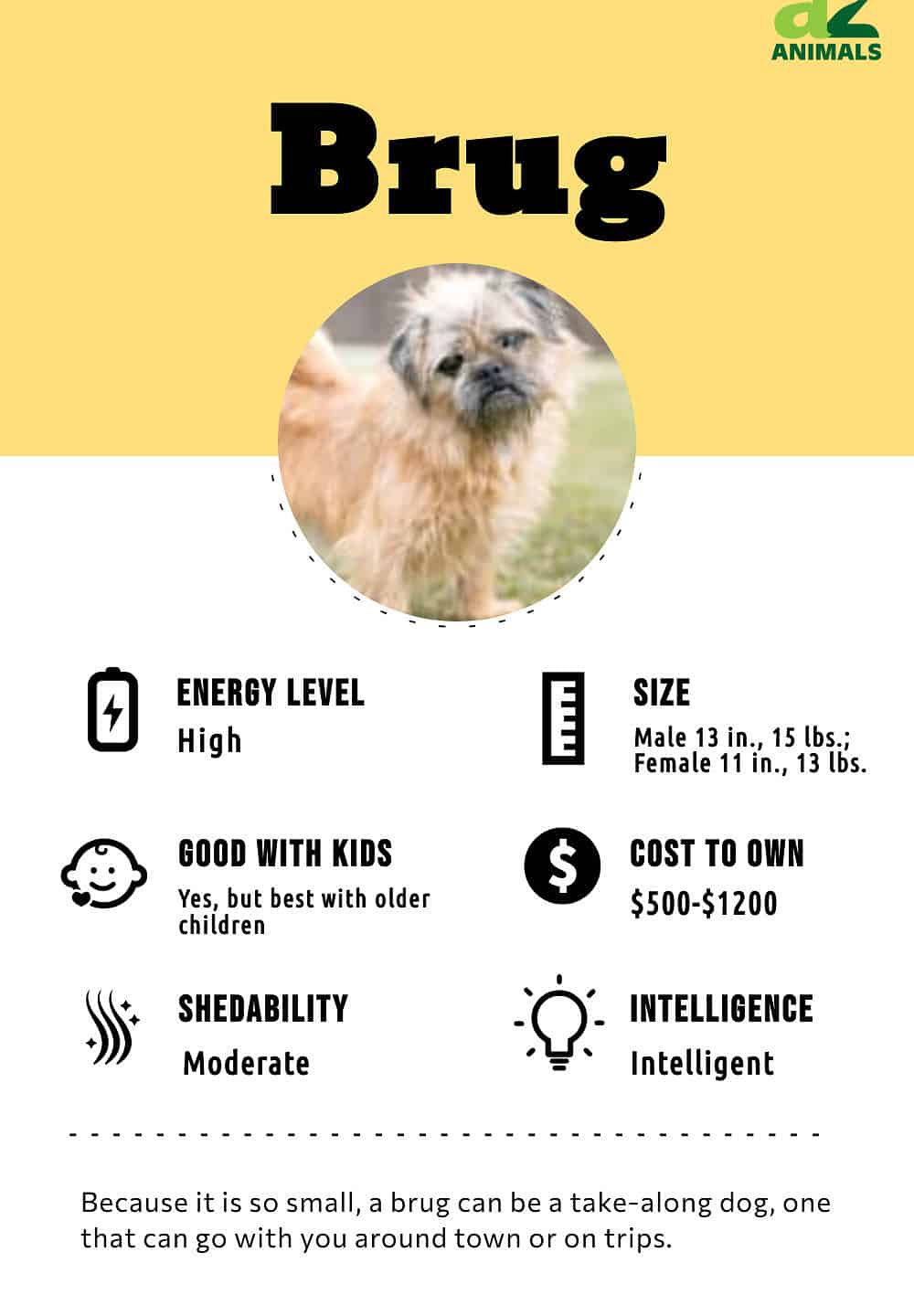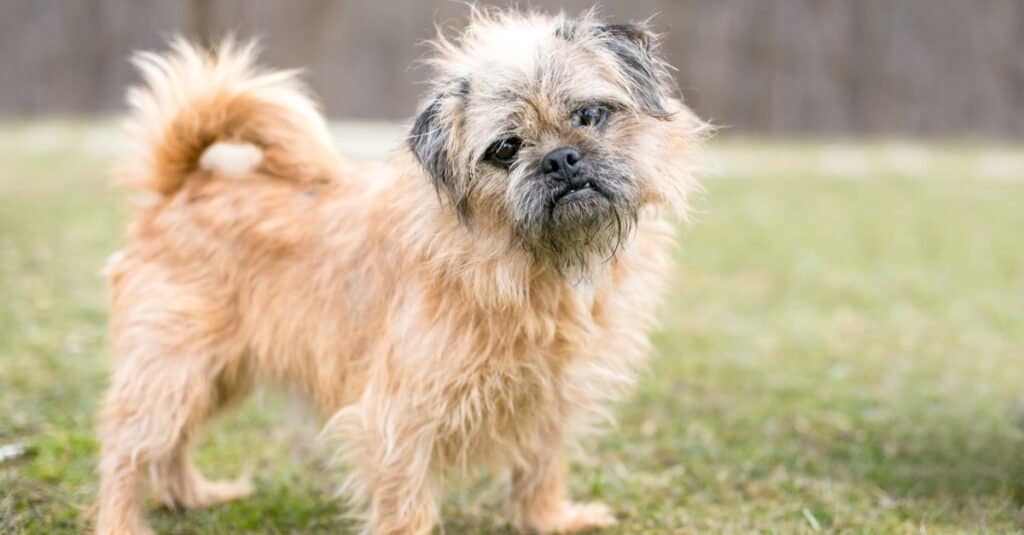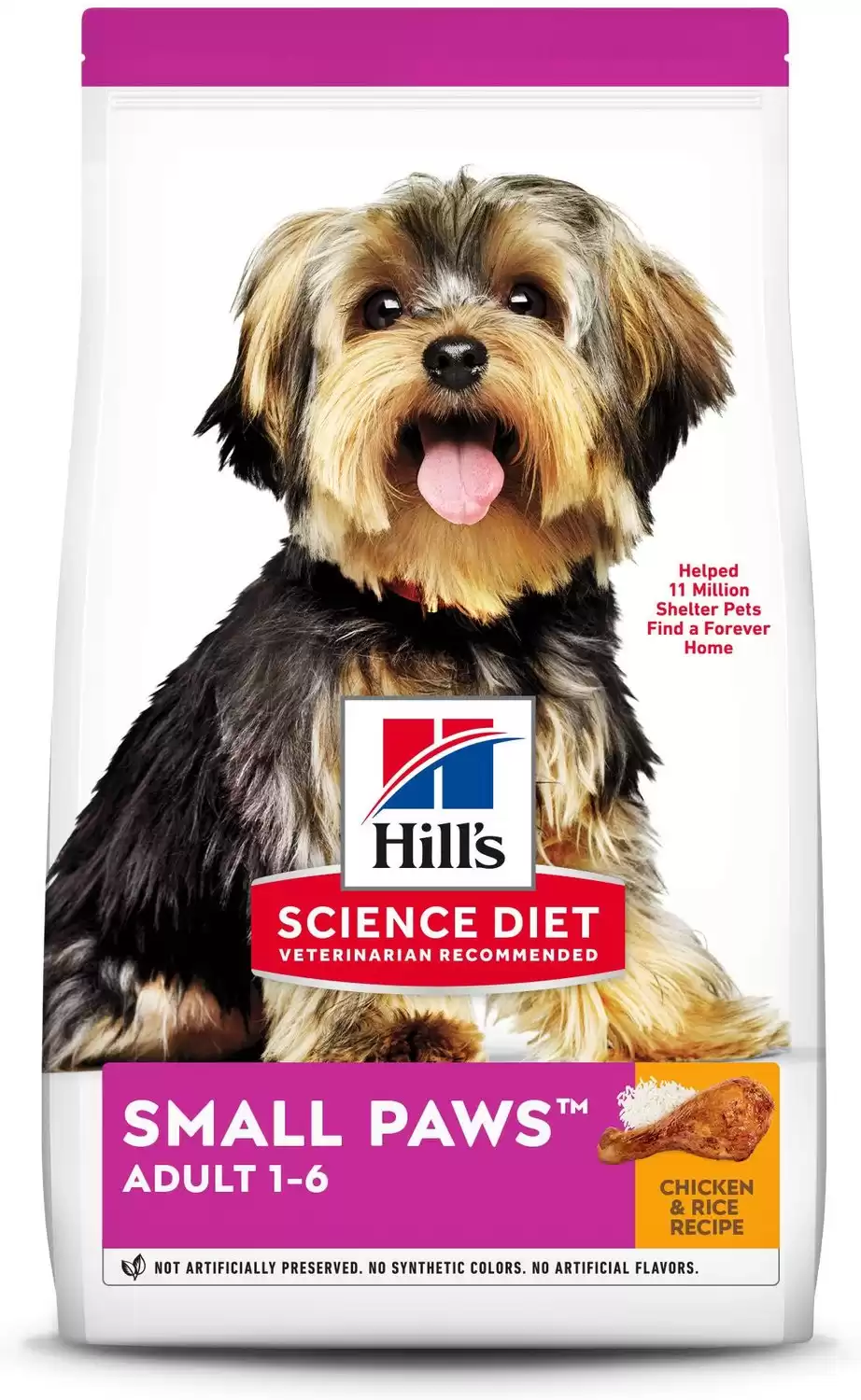Brug
Canis lupus
These small, confident dogs have no fear of approaching much larger dogs.
Advertisement
Brug Scientific Classification
- Kingdom
- Animalia
- Phylum
- Chordata
- Class
- Mammalia
- Order
- Carnivora
- Family
- Canidae
- Genus
- Canis
- Scientific Name
- Canis lupus
Read our Complete Guide to Classification of Animals.
Brug Conservation Status
Brug Facts
- Name Of Young
- Puppy
- Fun Fact
- These small, confident dogs have no fear of approaching much larger dogs.
- Other Name(s)
- Grifon Pug
Brug as a Pet:
- General Health
- Energy Level
- Shedability
- Trainability
- Intelligence
- Tendency to Chew
- Size
- Family and kid friendliness
- Yappiness / Barking
- High
- Separation Anxiety
- High
- Preferred Temperature
- Warm climate
- Exercise Needs
- Moderate
- Friendly With Other Dogs
- Moderate
- Pure bred cost to own
- $1,200
- Dog group
- Toy
- Male weight
- - lbs
- Female weight
- - lbs
This post may contain affiliate links to our partners like Chewy, Amazon, and others. Purchasing through these helps us further the A-Z Animals mission to educate about the world's species.
The confidence of a Brug means it has no fear in approaching dogs ten times its size.

A Brug dog has a level of confidence that far outsizes its small body. This canine is a mix between a Brussels Griffon and a Pug. It’s unclear exactly when and where the Brug originated, but each of its parents has a long history. Pugs date back to at least the 1600s in China while the Brussels Griffon breed originated in Belgium in the 1800s. The Brug is a part of the hybrid group of dogs.
See all of our expert product reviews.
The Brug dog has a loyal, affectionate temperament and a bold personality. This hybrid breed gets along best with older children in a family. Older children have more of a tendency to take great care when walking and running around with this tiny pooch so as not to injure it.
3 Pros and Cons of Ownership
| Pros | Cons |
|---|---|
| A take-along dog: The small size of this dog makes it easy to take it along on short drives, road trips, and everything in-between. | Questionable around small children: These pooches can nip at very young children who haven’t been taught to treat this tiny dog with care. |
| A vocal watchdog: This dog barks at the first sign of someone on its property. | Needs special attention in a household: Because this dog is so small, family members need to be aware of a Brug’s presence, so it’s not accidentally stepped on or hurt. |
| A small food budget: The monthly food budget is low for this small canine. | Patience Needed in Training: Despite being a smart, quick-minded dog, a Brug may reveal stubbornness during obedience training. |
Size and Weight
In terms of height, a male Brug dog can be 13 inches from head to paw. A female grows as tall as 11 inches. When it reaches adulthood, a male can weigh 15 pounds and a female can weigh 13 pounds. A seven-week-old Brug dog is four to five pounds. This canine is thought to be fully grown at nine months to one year of age.
| Height (Male): | 13 inches |
| Height (Female): | 11 inches |
| Weight (Male): | 15 pounds |
| Weight (Female): | 13 pounds |

©Mary Swift/Shutterstock.com
Common Health Issues
A dislocated kneecap, or patellar luxation, is one of a handful of common health issues of the Brug. An owner may see a Brug running along and suddenly begin limping. When the issue is minor, the kneecap can sometimes go right back into place without treatment. In other instances, physical therapy is necessary to treat patellar luxation.
The eyes of a Brug are the first thing you notice about this dog. So, it wouldn’t take long for an owner to notice a Brug’s entropion. Entropion is when one or both eyelids roll or push in on themselves. The small lashes on the eyelid rub against the dog’s eye causing pain. Surgery is often successful at treating this health issue.
Health and Entertainment for your Brug
See all of our expert product reviews.
Progressive retinal atrophy (PRA) is another eye ailment of this dog. It’s a disease that is not painful but causes a dog to lose its vision over time. No treatment is available for PRA at this time.
The most common issues for the Brug dog are:
- Patellar luxation
- Entropion
- Progressive Retinal Atrophy
Temperament and Behavior
The best word to describe this canine’s personality is bold. It’s not unusual for a Brug dog to charge up to a fully grown Labrador Retriever without hesitation. These hybrid dogs have a friendly and loyal temperament. In a household, it’s likely to form a strong bond with one person in the family.
Its curious mind is one of this canine’s most endearing traits. This little pooch needs to know everything that is happening in a household! Its huge eyes and sweet face make a Brug dog a welcome pet.
Care
For a family that purchases a puppy or adopts an adult Brug, it’s helpful to know all that can be done to increase its quality of life and its lifespan. Taking superb care of this pet means learning about its general health requirements, diet, exercise, and grooming regimen.
Best Dog Food
Although Brug puppies and adults may look similar in size, they each require a diet that supports their nutritional needs.
Brug puppy food: Carbohydrates are a must-have in the diet of these puppies. Carbs supply this small hybrid dog with energy and stamina for its daily activities. Protein supplies strength to its bones, muscles, and joints. Patellar luxation is an issue for this dog making protein all the more important in its diet. Omega 3 and 6 fatty acids are good for this puppy’s developing brain and vision. Fiber is necessary for the health of this pup’s digestion.
Brug adult dog food: Because small dogs like the Brug are prone to obesity, it’s important to lower the carbohydrate intake of an adult. The activity level of a family’s Brug should also be taken into account when deciding on carbohydrate intake. Protein in its diet nourishes this dog’s muscles and joints. Vitamin A is a nutrient that can aid in a Brug’s healthy eyesight. Keep in mind this dog is at risk for progressive retinal atrophy. Fiber is another critical piece in the diet of this adult dog.
According to A-Z Animals, the best dog food for Brugs is Hill’s Science Diet Dry Dog Food, Adult, Small Paws for Small Breed Dogs.
Since Brug owners’ number one health worry is their dogs’ eyes, they’ll be happy to reach for this dog food. It has everything to help keep Brug’s vulnerable eyes in working order- beta-carotene, vitamin A (also good for the skin), and taurine, which nourishes the heart, too. Since Brugs can struggle with their knees, the copper for connective tissues and plentiful calcium are encouraging.
Follow the link below to buy your Brug Hill’s Science Diet Small Paws on Chewy and Amazon.
- Chicken and rice formula for small breeds Adult 1-6
- Omega 6 fatty acids and vitamin E for healthy skin and shiny coat
- Natural ingredients and antioxidants for immune health
Maintenance and Grooming
Some Brug dogs have short, smooth hair while others have a longer, wiry coat. All Brugs need to be brushed two times each week. A slicker brush along with a comb can remove dead hairs and smooth its coat. Also, moisten a clean, soft cloth with warm water to wipe the underside of your pet’s ears. This takes away dust and excessive wax that could encourage the growth of bacteria and cause an infection.
How much does a Brug shed? It is a moderate shedder. Weekly grooming attention can help a family to avoid loose hair on the carpet and bedding. Getting rid of dead and loose hair from this dog’s coat sets the stage for new hair growth.
Flea allergies can be an issue for this hybrid breed. Red spots, flaking skin, and a lot of scratching are all signs of this issue. A vet can assist an owner in treatment for a Brug’s skin irritation and the underlying allergy.
Training
Of course, a family’s Brug dog needs to learn how to sit, stay, and heel, just like other dogs. When it comes to obedience training, a Brug learns its basic lessons fairly quickly. Keep in mind that some of these dogs can be distracted during sessions of training. So, keep treats on hand for success. Also, an encouraging tone of voice and words of praise are both very powerful tools in training.
This mix of intelligence and a tendency to become distracted is common in the Pug breed as well.
Exercise
Brugs have a large supply of energy contained in their little frame! A lively 30-minute walk in the neighborhood a couple of times a day is good for this canine’s physical and mental health.
The dog park is not a good idea for this particular pooch unless it’s able to exercise with other dogs of its size. Putting it in to run around with larger dogs may result in injury to a Brug. Games of fetch with appropriately sized toys are another way to get this canine moving.
Brugs are a suitable choice for someone who dwells in an apartment. For these dogs, an apartment has plenty of space to move around and relax.
Puppies
Brug puppies are extremely small, even after a few weeks old. One thing to remember is to use care when moving around these puppies. It’s very easy to unintentionally step on or close a door on a puppy.
Children
A family considering adopting or buying a Brug should understand this pet does best with older children. Understandably, it is always worried about being stepped on, fallen on, or otherwise treated in a harsh way. Its tiny body is much more vulnerable to injury than a larger, sturdier dog. Because the Brug dog is so sensitive to being stepped on or hurt, it may nip or bite a toddler or a young child who doesn’t yet know how to gently handle this pet.
Similar Dogs
Brussels Griffons, Pugs, and Pekingese are all similar to the Brug in a few ways:
- Brussels Griffon – Half of the Brug mix, this dog shares a long lifespan and an energy-filled personality with its hybrid offspring. But, a Brussels Griffon can have a coat with a red tinge while a Brug’s color can be a mix containing brown, black, cream, or white.
- Pug – This breed is the other half of the Brug mix. They share a high energy level and affectionate temperament. In terms of size, the Pug is prone to be a little heavier than a Brug.
- Pekingese – These two canines are very similar in size. A loyal temperament makes them both good lapdogs. Pekingese differ in their variety of coat colors.
Popular Names for Brugs
Some popular names given to these dogs:
- Penny
- Milo
- Rosie
- Lola
- Toby
- Frank
- Gizmo
- Jojo
Brug FAQs (Frequently Asked Questions)
What is a Brug dog?
A Brug is a hybrid dog. Specifically, it’s a mix between a Pug and a Brussels Griffon. It’s a small dog known for its bold temperament and loyalty to its owners. Their huge dark eyes and pleading expression are what convince many families to adopt or buy this pooch!
How much exercise does a Brug need?
They need 30 to 60 minutes of exercise each day. This level of exercise gives this dog the mental and physical stimulation it needs to be happy and healthy.
How much does a Brug cost?
Breeders put a price of around $1200 on this hybrid dog. Adopting one from a rescue organization that serves Brugs is a less costly way to own this canine.
The veterinary expenses for a Brug dog fall between $400 and $800 yearly.
Feeding a Brug is a relatively inexpensive task at a budget of $25 to $30 a month.
How long does a Brug live?
Brugs have a lifespan of 12 to 15 years.
Are Brugs good with kids?
Some yes, some no. Brugs are good with older children mostly because they understand the importance of handling and treating this dog with care. Alternatively, these dogs are prone to nipping at toddlers or younger children who handle them without enough care. This type of behavior is seen more out of self-protection than anger toward the child.
Thank you for reading! Have some feedback for us? Contact the AZ Animals editorial team.
Sources
- American Kennel Club, Available here: https://www.akc.org/dog-breeds/brussels-griffon/
- VCA, Available here: https://vcahospitals.com/know-your-pet/eyelid-entropion-in-dogs
- today's veterinary nurse, Available here: https://todaysveterinarynurse.com/articles/luxating-patellas-pathology-and-treatment-options/
- Wikipedia, Available here: https://en.wikipedia.org/wiki/Progressive_retinal_atrophy


















